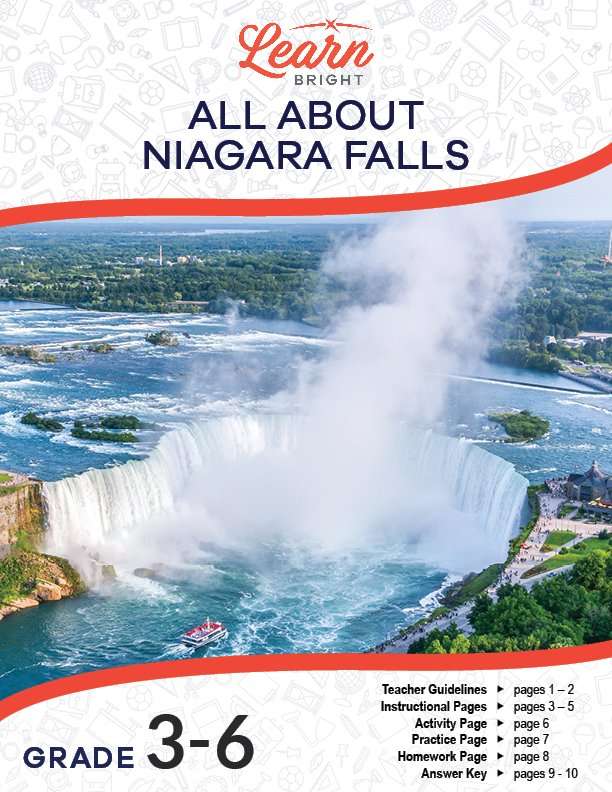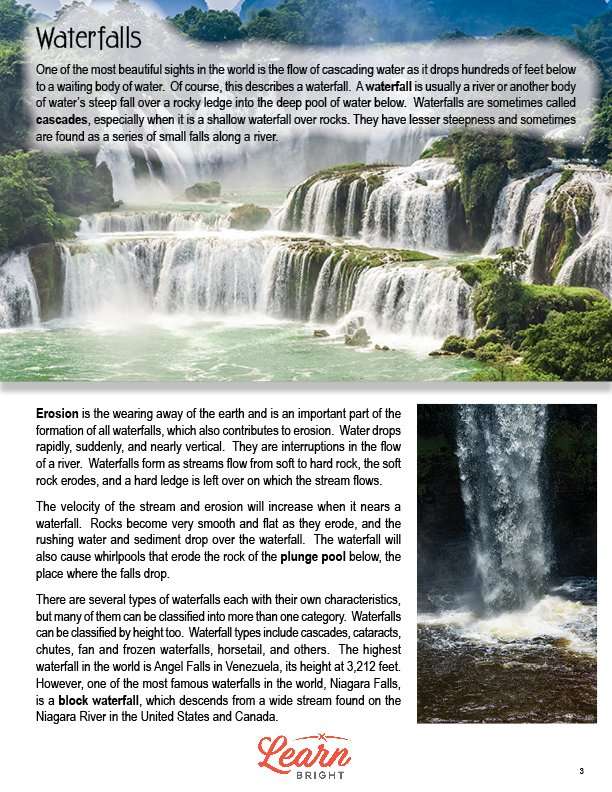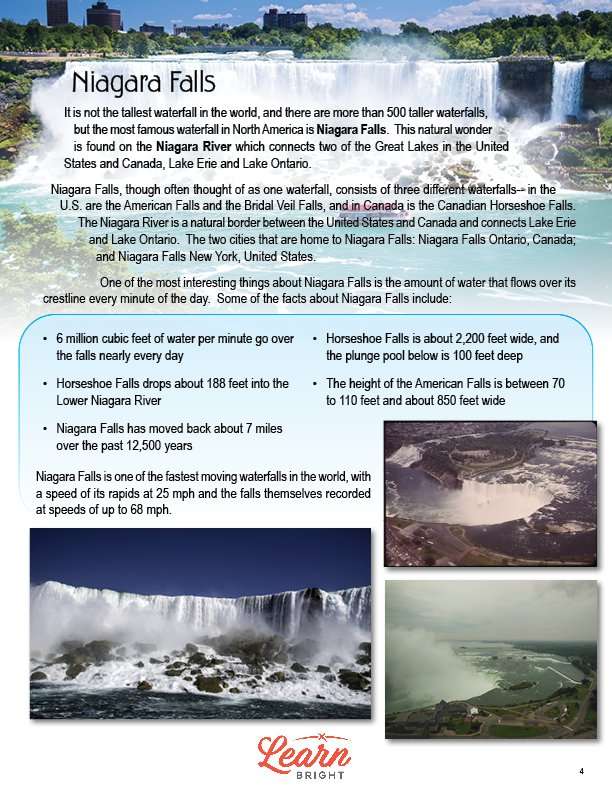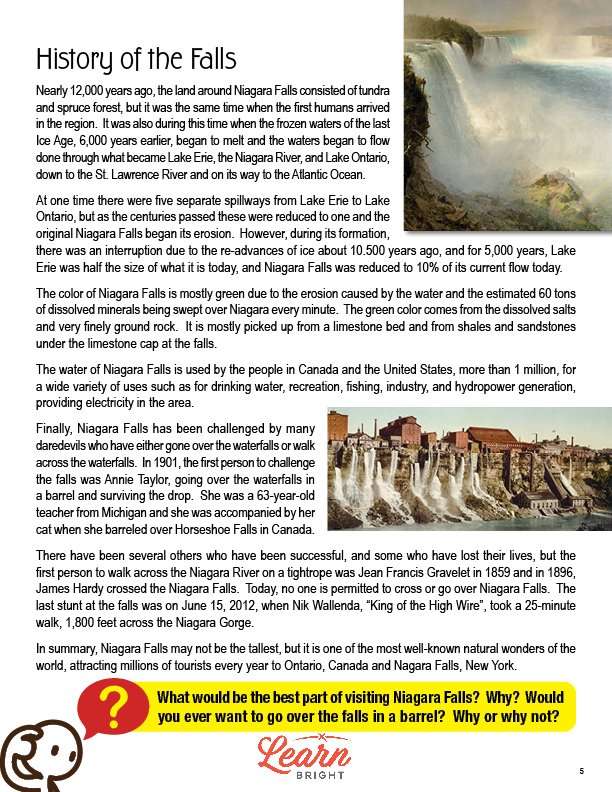Description
What our All About Niagara Falls lesson plan includes
Lesson Objectives and Overview: All About Niagara Falls teaches students about this amazing landmark. They’ll discover its unique history and find out what makes it so special. Along the way, they’ll also build their vocabulary by learning some key words and phrases related to Niagara Falls. This lesson is for students in 3rd grade, 4th grade, 5th grade, and 6th grade.
Classroom Procedure
Every lesson plan provides you with a classroom procedure page that outlines a step-by-step guide to follow. You do not have to follow the guide exactly. The guide helps you organize the lesson and details when to hand out worksheets. It also lists information in the orange box that you might find useful. You will find the lesson objectives, state standards, and number of class sessions the lesson should take to complete in this area. In addition, it describes the supplies you will need as well as what and how you need to prepare beforehand. To prepare for this lesson ahead of time, you can copy the handouts.
Options for Lesson
Included with this lesson is an “Options for Lesson” section that lists a number of suggestions for activities to add to the lesson or substitutions for the ones already in the lesson. One optional addition to the lesson activity is to have students vote on each other’s Niagara Falls poster to determine the best one, the most colorful, and more. An optional addition to this lesson is to show your class a video of someone going over the falls in a barrel or Nik Wallenda’s walk across the falls. You could also invite someone who’s been to Niagara Falls to speak to your class about it. Finally, you can have your students create a model of the falls or another type of falls or cascades.
Teacher Notes
The teacher notes page includes a paragraph with additional guidelines and things to think about as you begin to plan your lesson. This page also includes lines that you can use to add your own notes as you’re preparing for this lesson.
ALL ABOUT NIAGARA FALLS LESSON PLAN CONTENT PAGES
Waterfalls
The All About Niagara Falls lesson plan includes three pages of content. The lesson begins by describing waterfalls, which are usually rivers or another body of water’s steep fall over a ledge into a pool of water below. We sometimes call them cascades, especially when they are shallow and over rocks. These are generally less steep and we find them as a series of small falls alongside a river.
One important aspect of the formation of waterfalls is erosion. Erosion is when the earth wears away. With waterfalls, water drops suddenly and vertically. Streams flowing from soft to hard rock cause the formation of waterfalls, because the soft rock erodes. This leaves a hard ledge for the stream to flow over.
The closer you get to a waterfall, the faster the velocity of the water and the more erosion occurs. As rocks erode, they become smooth and flat and rushing water and sediment fall over the edge of the waterfall. Waterfalls also cause whirlpools, which erode rocks in the plunge pools (where the falls drop).
We have several different kinds of waterfalls, which all have different characteristics. Some waterfalls fit into multiple categories. We also classify them by height. Some types of waterfalls includes cascades, cataracts, chutes, fan and frozen, horsetail, and more. Angel Falls, located in Venezuela, is the highest waterfall in the world at 3,212 feet. One of the most famous waterfalls in the world, Niagara Falls, is a block waterfall, descending from a wide stream on the Niagara River in the U.S. and Canada.
Niagara Falls
Niagara Falls is not the tallest waterfall in the world—there are more than 500 taller waterfalls—but it is the most famous waterfall in North America. It’s located on the Niagara River and connects Lake Erie and Lake Ontario, two Great Lakes in the U.S. and Canada.
Niagara Falls is actually three different waterfalls: the American and Bridal Veil Falls in the U.S. and the Canadian Horseshoe Falls in Canada. This river acts as a natural border between the U.S. and Canada. Niagara Falls is in two cities, Niagara Falls, Ontario, Canada and Niagara Falls, New York, United States.
Every minute, 6 million cubic feet of water go over the falls. Horseshoe Falls is about 2,200 feet wide and drops around 188 feet into the Lower Niagara River. Its plunge pool is 100 feet deep. The American Falls are between 70 and 110 feet and 850 feet wide. Niagara Falls has moved back almost 7 miles in the last 12,5000 years and is one of the fastest moving waterfalls in the world. Its rapids move at about 25 mph and the falls move at speeds of up to 68 mph.
History of the Falls
The land around Niagara Falls around 12,000 years ago consisted of tundra and spruce forest. This was around the time that humans first arrived in the area and the frozen waters of the previous Ice Age began to melt. This caused water to flow down through what is now Lake Erie, the Niagara River, and Lake Ontario, to the St. Lawrence River and the Atlantic Ocean.
We used to have five different spillways from Lake Erie to Lake Ontario, but these eventually reduced to a single spillway, where the original Niagara Falls started eroding. The formation of the falls was interrupted by the reformation of ice after 10,5000 years ago. For around 5,000 years, Lake Erie was half its current size and Niagara Falls had about 10% of its current flow.
Niagara Falls are mostly green in color due to erosion, which sweeps 60 tons of dissolved minerals over the falls every minute. This color comes from dissolved salts and finely ground rock, mostly picked up from limestone beds, shales, and sandstones under the limestone cap. People in the United States and in Canada use the water from the falls for drinking water, recreation, fishing, industry, and hydropower, which provides electricity to the region.
Daredevils
Many daredevils have gone over, or walked across, the falls. The first person to do this was Annie Taylor, who went over the falls in a barrel in 1901 and survived! Taylor was 63 years old and a schoolteacher in Michigan at the time. She brought her cat with her when she went over Horseshoe Falls in Canada.
Several other people have successfully gone over the falls, but some others died trying. Jean Francis Gravelet was the first person to walk across the falls on a tightrope in 1859. In 1896, a man named James Hardy crossed the falls. Today, we don’t let anyone cross or go over the falls. The last stunt performed at the falls was in 2012, when a man named Nik Wallenda (also known as the “King of the High Wire”) walked 1,800 feet across the Niagara Gorge.
Even though Niagara Falls isn’t the tallest waterfall in the world, it’s one of the most well-known natural wonders we have. Millions of tourists travel to Ontario, Canada and Niagara Falls, New York to see them every year.
ALL ABOUT NIAGARA FALLS LESSON PLAN WORKSHEETS
The All About Niagara Falls lesson plan includes three worksheets: an activity worksheet, a practice worksheet, and a homework assignment. You can refer to the guide on the classroom procedure page to determine when to hand out each worksheet.
POSTER ACTIVITY WORKSHEET
For the activity worksheet, students will work with a partner to create a poster encouraging people to visit Niagara Falls. They will includes words, images, logos, slogans, a title, and more. Each pair will create a draft version of their poster before creating the final version.
Students can work either alone or in groups if you’d prefer.
MATCHING PRACTICE WORKSHEET
Students will complete three short matching exercises for the practice worksheet. For the first, they will match terms from the lesson with their definitions. For the second, they will match the information with the correct number related to Niagara Falls. Finally, for the third, they will match the description with the place.
ALL ABOUT NIAGARA FALLS HOMEWORK ASSIGNMENT
For the homework assignment, students will read ten questions related to Niagara Falls and choose the correct answer for each.
Worksheet Answer Keys
This lesson plan includes answer keys for the practice worksheet and the homework assignment. If you choose to administer the lesson pages to your students via PDF, you will need to save a new file that omits these pages. Otherwise, you can simply print out the applicable pages and keep these as reference for yourself when grading assignments.










